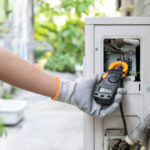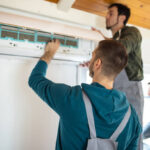
Air Conditioning Installation: The Guide to a Cool Home
In the scorching heat of summer, a reliable air conditioning system is no longer a luxury but a necessity. The installation of your air conditioner can significantly impact your home’s comfort and energy efficiency. In this article, we will provide a comprehensive guide to air conditioning installation, covering the process, benefits, and crucial considerations to ensure your cooling system operates optimally.
The Importance of Proper Installation
Energy Efficiency
The foremost reason for focusing on proper air conditioning installation is energy efficiency. A correctly installed system ensures that your AC unit operates at its peak performance, reducing energy consumption and ultimately lowering your electricity bills. This not only benefits your wallet but also the environment.
Longevity of Equipment
Proper installation increases the lifespan of your air conditioner. When your unit is installed correctly, it experiences less wear and tear, resulting in fewer breakdowns and a more extended service life. This can save you significant money on costly repairs or premature replacements.

Enhanced Performance
A professionally installed air conditioner provides consistent cooling throughout your home. It eliminates hot spots and ensures even distribution of cool air, greatly enhancing your overall comfort. Say goodbye to those uncomfortable rooms that never seem to cool down properly.
Steps in Air Conditioning Installation
Assessment and Sizing
Before installation, a thorough assessment of your home’s cooling needs is essential. An HVAC technician will calculate the right-sized unit for your space, ensuring efficient cooling without overworking the system. This step is critical for maintaining comfort and reducing energy waste.
Ductwork Inspection
If you have existing ductwork, it should be meticulously inspected for leaks or damage. Properly sealed and insulated ducts are essential for optimal airflow and energy efficiency. Neglecting this step can result in cool air escaping and higher energy bills.
Placement Considerations
The placement of your indoor and outdoor units is crucial. Factors such as shade, airflow, and accessibility must be taken into account. Proper placement prevents overheating, reduces strain on the system, and makes maintenance easier, ultimately extending the lifespan of your AC unit.
Electrical Wiring
Professional electricians should handle the electrical wiring for your new AC unit. They ensure that the wiring can handle the load, preventing power surges, electrical malfunctions, and potential safety hazards.
Refrigerant Handling
Proper handling of refrigerant is critical for efficient cooling and environmental protection. Only certified technicians should handle refrigerant to prevent leaks, which can harm the environment and decrease your system’s efficiency.
Testing and Calibration
After installation, a comprehensive testing and calibration process ensures your system works flawlessly. This includes checking airflow, thermostat settings, and cooling performance. It’s the final step in guaranteeing your home’s comfort.
DIY vs. Professional Installation
DIY Installation
While some homeowners may attempt a DIY installation to save money, it’s important to understand the risks involved. Improper installation can lead to costly repairs, reduced efficiency, and even safety hazards. Unless you have extensive HVAC knowledge, professional installation is strongly recommended.
Professional Installation
Hiring a professional HVAC technician ensures a seamless and safe installation process. They possess the expertise, specialized tools, and experience to guarantee that your system operates optimally. Professional installation is an investment in your comfort and system longevity.
Conclusion
In conclusion, air conditioning installation is a pivotal step in creating a cool and comfortable environment within your home during scorching summer months. Prioritizing proper installation not only enhances energy efficiency but also extends the life of your equipment. Whether you opt for DIY or professional installation, ensure that your AC unit is installed correctly to enjoy years of reliable cooling.
Frequently Asked Questions
How long does a typical air conditioning installation take?
The duration of installation varies depending on factors like system complexity and home size. On average, it can take anywhere from a few hours to a full day. Complex installations or ductwork modifications may take longer.
Is professional installation more expensive than DIY?
Professional installation may have an upfront cost, but it can save you money in the long run by preventing potential issues and ensuring energy-efficient operation. It’s a worthwhile investment in your home’s comfort and your wallet.
Can I install an air conditioner without ductwork?
Yes, you can opt for ductless mini-split systems that don’t require traditional ductwork. This makes them suitable for older homes or specific cooling needs, offering flexibility in installation.
What maintenance is required after installation?
Regular maintenance is essential to keep your air conditioner running smoothly. This includes cleaning or replacing filters, inspecting ducts for leaks, and scheduling annual professional servicing to ensure peak performance.
Are there any rebates or incentives for energy-efficient installations?
Many regions offer incentives, rebates, or tax credits for installing energy-efficient air conditioning systems. Check with your local utility company or government agencies to explore available programs and potential savings opportunities.



